From the Oxford Dictionary a bunker is defined as a reinforced underground shelter, typically for use in wartime. From the online encyclopedia Wikipedia a bunker is a defensive military fortification designed to protect people or valued materials from falling bombs or other attacks. Bunkers are mostly below ground, compared to blockhouses which are mostly above ground.
I bring this up because I think almost every prepper has dreamed about having some sort of bunker. My brothers and I have spent many hours discussing building methods and materials although we have yet had the opportunity to embark on the effort. The industry is large enough that there are companies earning large sums of wealth via prefabbed shelters built of reinforced materials that can be simply lowered into the ground and covered with earth. If you’re like me you probably can’t afford the additional house payment.
In our youth we built our fist bunkers as a result of childhood games. We dug a series of trenches and rooms which we subsequently covered with timbers and old boards. The soil we removed from the ground was used to cover the structure and within a few months it was well covered with weeds and nicely concealed. The structures cost us nothing more than time.
The limits to affordable bunker building come down to your innovative imagination and what extremities you are preparing for. Here are some things worth considering from a Smart Product Technology article titled Underground Bunkers Now and Then and The top ten things to consider when planning a bunker:
1) Affordability Assessment. We purchase car insurance, health insurance and even life insurance for when we die…. How about purchasing some insurance to help you and your family live?? How much are you willing, or can you afford to invest in a survival plan for your family? You have basically 4 choices.
2) Risk Assessment. I categorize the risk into 2 categories. Natural disasters or manmade disasters. What disaster are you most likely to be confronted with?
3) Household Survival Plan. Are you a stockpile and stay put for a long term family? These shelters are typically your larger deep underground systems and are very expensive. Although they have a better comfortability factor then small shelters there are also some serious drawbacks to the systems. If it’s not located on your immediate property you may not be able to get to it for starters. Did any neighbor see you craning it into the back yard?? If so… they may respect your privacy for a week or so but eventually when there is no water or food they will come knocking on your hatch. If one person knows outside of your family, that could be the difference between life and death. Another drawback is perhaps just 30miles away things are un affected. You will be stuck in your large bunker stuffed with everything you need because you can’t move all your stores. These consequences will cause you to have an enormous need for security.
Or
Are you a “survive the initial event in your smaller shelter” planner that can move when necessary to new locations and return when necessary as fluid events take place. You will need alternate locations to go to. Know your escape routes. Green belts and power line easements are wonderful. Stockpiles can be stored in your security pod. We live 30 miles from the ocean so after a week or two of an event we will make our way to the water and out to see. We will seek out a location unaffected by the disaster. We have buried a few 5 gallon pales with provisions along the routes and have geo cached them. Even small systems can be used for long term stays but they just are not as comfortable as large systems.
4) Geological Assessment. What type of geological substructure are you sitting on? Do you have allot of boulders, Granit, or other hard substrate? Is the ground porous? Clay? How shallow is the water table in the spring and winter? Are there ponds or lakes nearby? These things need to be considered. Water is especially a problem for underground systems. If you think water could affect you will need a water proof system such as the Security Pod by Smart Product Technology.
5) Shelter sizing. How many people will be in your shelter? Keep in mind the amount of food water and air everyone in the shelter will need. The minimum water for a grown man is 10 cups a day. A minimum 1,200 calories a day to keep the body from feeding off of itself. An adult will require approximately 10 cubic feet of natural atmosphere per hour for breathing for an adult.
6) Choosing a shelter location.
Long term stay put shelters.
Remember you cannot move! You are married to your long term bunker. The biggest drawback is the lack of secrecy when installing such a system. If it’s located in your back yard and you live in the suburbs that would probably mean that your neighbors saw you craning it over the house or saw all the concrete and pump trucks in your yard. Chances are you also told someone what you were doing and asked them not to say anything. Asking someone not to say anything is really asking them just to tell their closest friends only….then the closest friend does the same thing and so on and so on. The best security is that no one knows about the bunker! Not even the neighbor. For security reasons it is better to place such a large bunker on remote property outside of the view of neighbors. That creates a new problem… It’s not quickly accessible and that will limit what events it can be used for. People that know you have emergency supplies may respect your privacy the first week or two but when things become desperate you will hear the knock knock on your hatch.
Smaller urban foxhole shelters
It is highly recommended that the shelter be installed with an entrance inside your home or on your immediate property with the entrance only steps from the house. When the entrance is inside your home you will have the maximum use and security for the shelter. Entering from inside the home allows additional uses such as safe rooms for home intrusions. You can occupy both the residence and the shelter going in and out of either as necessary without exposing yourself to the outside. These systems are far less expensive then the large bunkers but come with air systems and locking systems just like the big ones.
7) Shelter entry system. There are a number of hatches available. The least expensive systems are heavy and hard to manage. To get a good sized opening with hydraulic assists is going to cost between 8,000 and 20,000. This is one of the most important elements of your bunker. This will protect you from blasts, water intrusion, zombies, grenades or whatever you think you need to be protected from. It’s always good to have a 2nd exit incase debris falls on your shelter. Smart Product Technology Security Pods come with a jacking system to hydraulically lift debris off of you from inside the shelter. They also have flush floor hatches that can be driven over by vehicles that are easily disguised on a garage floor with drip pans or carpet. Patio or garden entrances offer other benefits in a hatch such as view ports.
8) Shelter Air System. You must insure that you have the ability to bring in fresh air and filter the air for different circumstances. Your air system needs to be protected with devices such as blast valves (they will keep concussions from hammering you with pressure waves while you are inside the shelter), overpressure or positive pressure valves. Your snorkel lines need to be plumbed with galvanized schedule 40 steel minimum to withstand earth movement. You system should have battery and manual back up. You should calculate the number and kinds of filters you need to have on hand. Plan how you will terminate your outside snorkels. They can be placed in a rock pot or they can be brought up and turned over and look like oil tank vents.
9) Emergency Escape System. You never want you bunker to be your coffin, so make certain you have an emergency escape. It does not have to be a separate entrance although I can be, but they cost more money. You can hide an emergency exit in a sand filled hole. You drain the sand into the bunker to open it. Or you can make sure the system you buy has the ability to hydraulically lift the hatch and whatever else might be parked on you up.
10) Top things to have in your survival shelter. 1) Dependable air supply and filters. 2) Water!!. 3) Food Reserves. 4) Sanitation Necessities. 5) Communication Systems. 6) Emergency Exit Plan to Leave the Shelter and the Area. 7) Self Defense Tools. 8) First Aid Supplies. 9) Items to keep people occupied. Small games, card games and dice games are good. Bibles or books to read. Chores and duties for people to perform. Fighting boredom may determine how long people are willing to put up with such restricted conditions. 10)Batteries! and lots of them. Protected in a faraday cage
Some personal thoughts:
1) Home vs. bunker. What do you keep at your shelter and what do you keep at home. Because I only have a moderate sized hidden storage container above ground I’ve found it worthwhile to personally keep food storage, weapons, and bug out bags at home; while everything not immediately needed is kept at the shelter (one day to be bunker).
2) Are you concerned with firing ports and booby trapping the hell your of you location?
3) Are you worried about concealment from enemy forces or aerial surveillance?
4) How are you going to maintain personal hygiene and waste disposal?
In regards to blast protection Bunkers deflect the blast wave from nearby explosions to prevent ear and internal injuries to people sheltering in the bunker. While frame buildings collapse from as little as 3 psi of overpressure, bunkers are regularly constructed to survive several hundred psi. This substantially decreases the likelihood that a bomb can harm the structure. The basic plan is to provide a structure that is very strong in physical compression. The most common purpose-built structure is a buried, steel reinforced concrete vault or arch. Most expedient (makeshift) blast shelters are civil engineering structures that contain large buried tubes or pipes such as sewage or rapid transit tunnels. Improvised purpose-built blast shelters normally use earthen arches or vaults. To form these, a narrow (1-2 meter) flexible tent of thin wood is placed in a deep trench (usually the apex is below grade), and then covered with cloth or plastic, and then covered with 1–2 meters of tamped earth. A large ground shock can move the walls of a bunker several centimeters in a few milliseconds. Bunkers designed for large ground shocks must have sprung internal buildings to protect inhabitants from the walls and floors.
Concerning nuclear protection bunkers must also cope with the under pressure that lasts for several seconds after the shock wave passes, and block radiation. Usually these features are easy to provide. The overburden (soil) and structure provide substantial radiation shielding, and the negative pressure is usually only 1/3 of the overpressure.
General features of a bunker are many. The doors must be at least as strong as the walls. The usual design is a trap-door, to minimize the size and expense. To reduce the weight, the door is normally constructed of steel, with a fitted steel lintel and frame. Very thick wood also serves, and is more resistant to heat because it chars rather than melts. If the door is on the surface and will be exposed to the blast wave, the edge of the door is normally counter-sunk in the frame so that the blast wave or a reflection cannot lift the edge. A bunker should have two doors. Door shafts may double as ventilation shafts to reduce digging.
In bunkers inhabited for prolonged periods, large amounts of ventilation or air conditioning must be provided in order to prevent ill effects of heat. In bunkers designed for war-time use, manually operated ventilators must be provided because supplies of electricity or gas are unreliable. One of the most efficient manual ventilator designs is the Kearny Air Pump. Ventilation openings in a bunker must be protected by blast valves. A blast valve is closed by a shock wave, but otherwise remains open. One form of expedient blast valve is tire-treads nailed or bolted to frames strong enough to resist the maximum overpressure.
If a bunker is in a built-up area, it may have to include water-cooling or an immersion tub and breathing tubes to protect inhabitants from fire storms.
Bunkers must also protect the inhabitants from normal weather, including rain, summer heat and winter cold. A normal form of rain proofing is to place plastic film on the bunker’s main structure before burying it. Thick (5-mil or 0.13 mm), inexpensive polyethylene film serves quite well, because the overburden protects it from degradation by wind and sunlight.
If you are curious, some of this material came straight out of Wikipedia, because as I was gleaning some additional insight; I found the information too good in its original state. the pictures below are jsut some great old vintage black and whites to get the wheels in your head spinning.
Jon
For further reading check out:


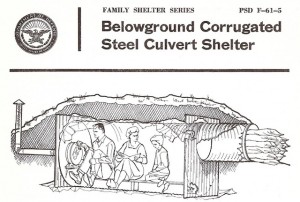

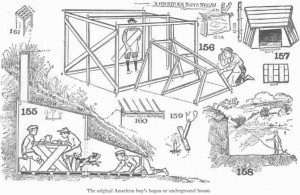
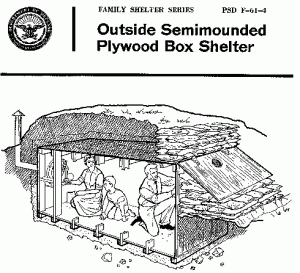
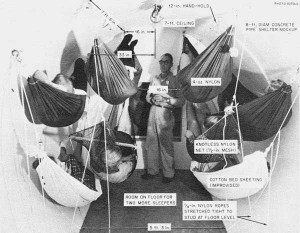
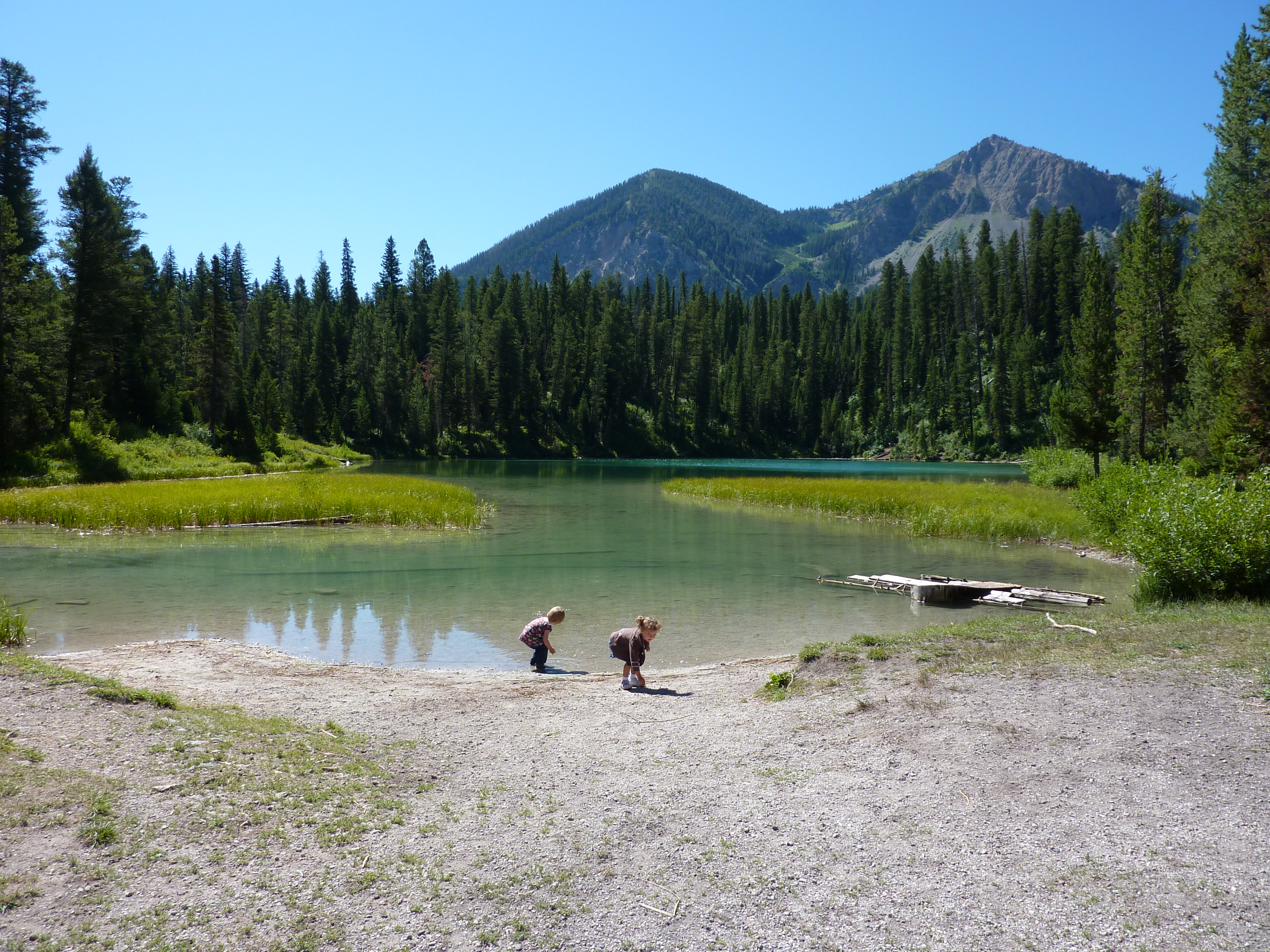
Leave a Reply